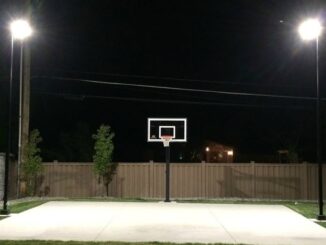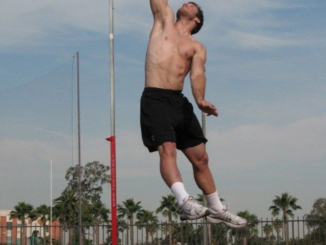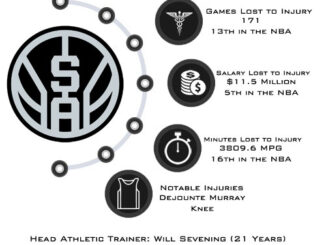
Defensive techniques used in preparing for football games can be applied to those used in basketball. In football, the aim is to use schemes, formation, and techniques which limit the advancement of the ball. One technique is to identify the tendencies and find ways to counteract them. For instance, in basketball, if you found a way to decrease the opponent’s shooting percentage by five percent, that could create a differential of six to eight points. That’s a worthy accomplishment.
Let’s begin by looking at the man-to-man defensive techniques. One of the first determinations is the dominant hand of your opponent; either right-handed or left-handed. This is the shooting hand, and it determines how you guard your man and obstructing the shooting path. The next determination is which foot is the pivot foot. This can change with possessions and determines the drive side tendency, frequently to the non-pivot foot side. Another tell is the hand position on the ball. Shooting hand behind the ball indicates preparing for a shot. Hands to the side of the ball indicate preparing to pass. Hand on the upper part of the ball indicates preparing to dribble and which hand indicates going left or right.
Another indicator is dribble patterns. Players who dribble between the legs or behind the back do so in repeated patterns prior to shooting or driving to the basket. Knowing that tendency gives the defensive player a slight edge, a fraction of a second to contest the shot or dribble drive. Contested shots or drives decreases the scoring percentage and by how much depends on the agility and quickness of the defensive player. It also depends on the player’s ability to read and react to indicators.
Reading tendencies can likewise assist in making steals. By watching dribble rhythms and patterns, the defensive player can predict where the ball is going to be and can poke at that spot deflecting the ball. Such a move requires knowing at what point to attack and with practice become instinctive instead of mental. Targeting too early allows the opponent to redirect the dribble and too late leaves the defender out of position. The attack point is usually as the dribbled ball is ascending to the opponent’s hand where a dribble follows the predetermined pattern. Stealing the ball in this way not only wreaks the opponent’s confidence, but it also adds two points to the scoring differential. It stops a scoring attempt averaging one point per possession and allows a scoring opportunity by the defense averaging one-point per.
Team defense combines the aforementioned techniques but adds coordinated moves of helping out. This could be impending or cutting off passing lanes or even trapping a stationary player and obstructing passing or shooting lanes. Other times it’s correcting a mismatch such as a short player guarding a tall one, or an exceptional shooter facing a mediocre defender. Helping out is a constant risk-reward choice as double-teaming can have positive results or it can leave an opponent completely open. Thus, helping out requires all five defensive players working as a team. This means when one player moves to help out, the defensive responsibilities of the other three changes.
How it changes depends on the skill set of your opponents. For instance, a low-percentage outside shooter requires less attention than an inside center who dominates the paint scoring and rebounding. Such a player would require special treatment including double-teaming, sagging defense, and/or denying him the ball.
A major defensive problem is dealing with screens, the peel-off, and resulting mismatches. This is where analysis of tendencies can become a big advantage. Do they use the screen to set up an open shot or a drive to the basket? Or do they use it as a slip screen where the screener peels off toward the basket? How you defend it depends on their tendencies and the scoring threat of the players involved. Good defense requires making calculated choices that result in the best outcome.
Any defensive team is not going to be able to shut down an offense. Instead, the objective should be to limit points per possession. Defensive rebounding plays into this scenario as limiting second chances greatly reduces points per possession. While the defense has an advantage by being closer to the basket, it can up this advantage by solid rebounding techniques. Blocking out your opponent is basic, but defending likely landing spots is just as important. For instance, missed mid-range jumpers fall closer to the basket versus long three-pointers. Layups and put-backs are closer yet. Using this information can increase the rebounding percentages.
In addition, rebounding position is more important when facing taller, more athletic players. Blocking out is not enough, one must keep one’s opponent off balance by maintaining contact and restricting their jumping ability.
Switching is another defensive ploy where players pass off guarding responsibility to another player. This could be a verbal or non-verbal exchange and is commonly employed in high-screen pick and roll situations. Most of the trouble in this area is that the switch is not definitive and one or both offensive players have an advantage. Players get caught in that area of indecision and offensive players are left uncontested. Communication is a must remedy for such situations. Likewise, going to a mini-zone defense helps correct such mismatches and allows players to regroup.
In a zone defense, players are assigned an area to guard instead of a player. Usually, players move in a formation angling toward the ball with little separation between them. This spacing reduces dribbling or drives to the basket. Thus, the offense is relegated to passing the ball to an open man and taking mostly long shots. One strategy in this defense is to encourage shooting by low percentage shooters and play for the rebounds. Another strategy is to contest shots by likely shooters thereby reducing percentages.
Zone defense requires discipline in maintaining spacing and moving to the ball in a decisive and confronting manner. Here again, passing patterns soon emerge that predict scoring chances and which players are likely to shoot and when. This information allows the defense to increase confrontations at those moments. Such an intense defense can be exhausting and requires recovery moments. These can be taken on offense walking the ball up the court, taking time off the clock and shooting later during the shot clock. Keeping up a high-paced game can be regressive and detrimental to a winning cause. Thus, attention to recovery is a must.
On defense, you have several allies, namely the sidelines, the five-second rule, and the shot clock. When opponents get next to the sideline, it’s like you have another defender on them as they can only go sideways. And if they have used their dribble, it’s a tense moment which could lead to a turnover. Likewise, when pressed they may step back out of bounds. So, steering your opponent to the sidelines is a good thing and creates more chaotic moments for the offense.
Taking advantage of the five-second rule on out-of-bounds throw-ins can be instrumental in tight games. Taking over five seconds results in a turnover. When the offense has to go the length of the court, one can take risks and go for a quick turnover. As such, the defensive alignment that smothers the throw-in should be a rapid accumulation of defenders. First one, then two, and quickly three all blocking every possible passing lane create a chaotic challenge for the passer. Does the passer chance an interception or does he have time to call a time out?
In college, the five-second rule also applies to an offensive player being closely guarded by a defender and not advancing the ball toward the basket. This rule eliminates a dribbler running out the clock with no attempt to score. Here again, when defenders smother the dribbler and obstruct passing lanes, such action can result in a violation and turnover.
Being cognizant of the shot clock can also produce positive results, for when there are five to seven seconds remaining, the offense is compelled to get a shot off. This is the time to disrupt the flow and step of the defensive attack. By inhibiting passing to primary shooters, more time is run off thereby rushing poorer shooters to take bad shots. Such a strategy requires the defense knowing the skill set of offensive players and their shooting percentage, then defending accordingly.
While scouting strategies are common in football, awareness, and application of them in basketball can be a game changer. These strategies could emerge through studying opponent’s stats and videos, or by in-person observations and scouting reports. By countering the tendencies, the skill sets of the opposition, a team can gain an advantage against formable opponents. Knowing what your opposition is likely to do is smart basketball. However, you need to know which tendencies to look for and how to incorporate appropriate countermeasures into your game plan. That’s not only smart basketball, but it’s also brilliant.
The author wrote a companion article on the offensive aspect entitled, “Basketball: 5-Player Schemes Promote Winning Ideals.”
Unless otherwise stated, PONIREVO and/or its licensors DO NOT own any intellectual property rights in the website and material on the website. Majority of the site’s content has been scraped and auto posted by a third party artificial intelligence program —– PONIREVO Creation Team.
Proudly WWW.PONIREVO.COM



